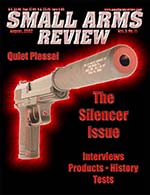SITREP: August 2002
By Dan Shea
Silencers. The images conjured up by that word are very seldom positive in the minds of the general public. 75 years of Hollywood making bad guys commit crimes with them have left a negative image in the minds of the public. Add the years of the anti Second Amendment fanatics throwing scare tactics at the debate, usually unopposed, and you have the modern day scenario of registration and restriction.
The fact is, most other civilized countries have relatively liberal laws regarding suppressor ownership. Most societies consider it a courtesy to use a suppressor on you firearms, so as not to jolt the neighbors when you shoot, and to keep noise pollution down.
Use of suppressors is not restricted to James Bond, or the “Bad Guys”... the vast majority of firearms suppressors are used by people who want to shoot either recreationally and protect their hearing, or by farmers or professionals who use the suppressors to mask the sound of removing rabid or unwanted animals. In other words, to keep from disturbing the citizens. The law enforcement use of suppressors is not some Bondian fantasy world of super spies taking each other out, it is for such mundane purposes as quietly taking out a porch light when a tactical team needs to move in darkness to keep from being targets, or shooting out a vehicle mirror so a madman who took a bus full of people hostage can’t see them as they maneuver to rescue, or so that they can communicate over gunfire in a building clearing event.
Suppressors also allow for officers to keep their night vision in a dark situation where they have to make life or death choices.
Military forces have different purposes for masking sound, which we have gone over in SAR at other times.
However, everyone around firearms would benefit from the common use of firearms suppressors. Protecting our hearing is important. Try and have a conversation with old machine gunners- “Joe, what time is it?” “Fine thanks- want some chips?” “What about my hips?” “No more clips? I can’t hear you” “You can’t have a beer- we’re at the range!” “I’m strange? What the *&^% are you talking about?”
I suspect long time friendships have been lost over the missing high frequency sounds inherent in human conversations... or at least many things have been muddled. I once was sent to the hearing doctor by my wife, and the doctor told her I had “Selective hearing”. You married guys, try living THAT one down. Actually, I have high frequency hearing loss, like all shooters do in varying degrees. (So do old rock n rollers, by the way- if you are both, you can expect to start reading lips soon).
The fact is, sound suppressors should almost be mandatory in the shooting sports, and in training environments. Sound suppression is important, and your hearing doesn’t grow back once it’s gone. I believe we are about to see a major move by many agencies to provide sound suppression in training.
In this issue of SAR, we tried to give a good cross section of the suppressor manufacturing community. We have tests of old and antique items, as well as some of the newest products on the market. We also have some very interesting interviews. I chose these subjects to interview due to their long time in the business, and the historical overview these people can give to the readers. Out of about 30 people who have been integral to the last 40 years of suppressor designs in the United States, we managed to get 7 into the issue.
We hope you enjoy the issue, and as a note to the newer suppressor manufacturers, I personally hope you enjoy this glimpse into the early years of some of the legends in the business- it should be interesting and hopefully inspiring to see where these companies came from- humble origins, hard work, devotion to testing and design, and many were around earth shaking events and covert agencies. Their determination and plain old stick-to-itiveness will hopefully provide inspiration for many years to come
- Dan
This article first appeared in Small Arms Review V5N11 (August 2002) |
| SUBSCRIBER COMMENT AREA |
Comments have not been generated for this article.



